Top NPS Benchmark Insights for Enhanced CX Strategies

Net Promoter Score (NPS) benchmarks guide you in refining customer acquisition strategies. By analyzing customer feedback, you gain insights into loyalty, satisfaction, and areas that need improvement. In 2025, businesses will rely more on AI-powered tools to personalize NPS surveys and collect feedback across multiple channels. Real-time analysis and customer journey mapping will help you adapt to evolving expectations. For industries like hospitality or technology, benchmark net promoter score ranges like 40-70 or 40-60 ensure you stay competitive. Solutions like Sobot’s enhance customer interactions, making it easier to achieve higher NPS and drive customer acquisition.
Understanding Net Promoter Score and Its Impact on CX
Defining Net Promoter Score: A Key Metric for Customer Loyalty
Net Promoter Score (NPS) measures how likely your customers are to recommend your brand to others. It categorizes respondents into three groups: promoters, passives, and detractors. Promoters are loyal customers who actively advocate for your brand, while detractors are at risk of leaving or spreading negative feedback. Passives fall in between, showing satisfaction but lacking enthusiasm.
NPS is a powerful tool for understanding customer loyalty. Studies show that promoters are 50% more likely to make repeat purchases, and loyal customers spend up to 67% more. Addressing detractors can increase retention by 12%, reducing churn and improving profitability. High NPS scores often correlate with strong customer trust, repeat business, and organic growth through word-of-mouth referrals.
How Benchmark Net Promoter Score Shapes CX Strategies
Benchmarking NPS against industry standards helps you identify where your customer experience stands. For example, the average NPS for the retail industry is 29, while streaming media averages 29 as well. Companies with high NPS scores, such as those above 50, often see increased customer retention and higher lifetime value.
You can use NPS benchmarks to guide strategies like cross-tab analysis, which breaks down feedback by customer type or interaction channel. Correlation analysis links NPS to factors like response times or product quality, helping you pinpoint areas for improvement. Sentiment analysis quantifies qualitative feedback, revealing recurring themes that impact customer experience.
| Strategy | Description |
|---|---|
| Cross-tab analysis | Break down feedback by customer type, purchase history, or interaction channel. |
| Correlation analysis | Examine how NPS relates to factors like response times and product quality. |
| Sentiment analysis | Categorize open-ended feedback to identify recurring themes. |
The Role of Sobot in Enhancing NPS Through Contact Center Solutions
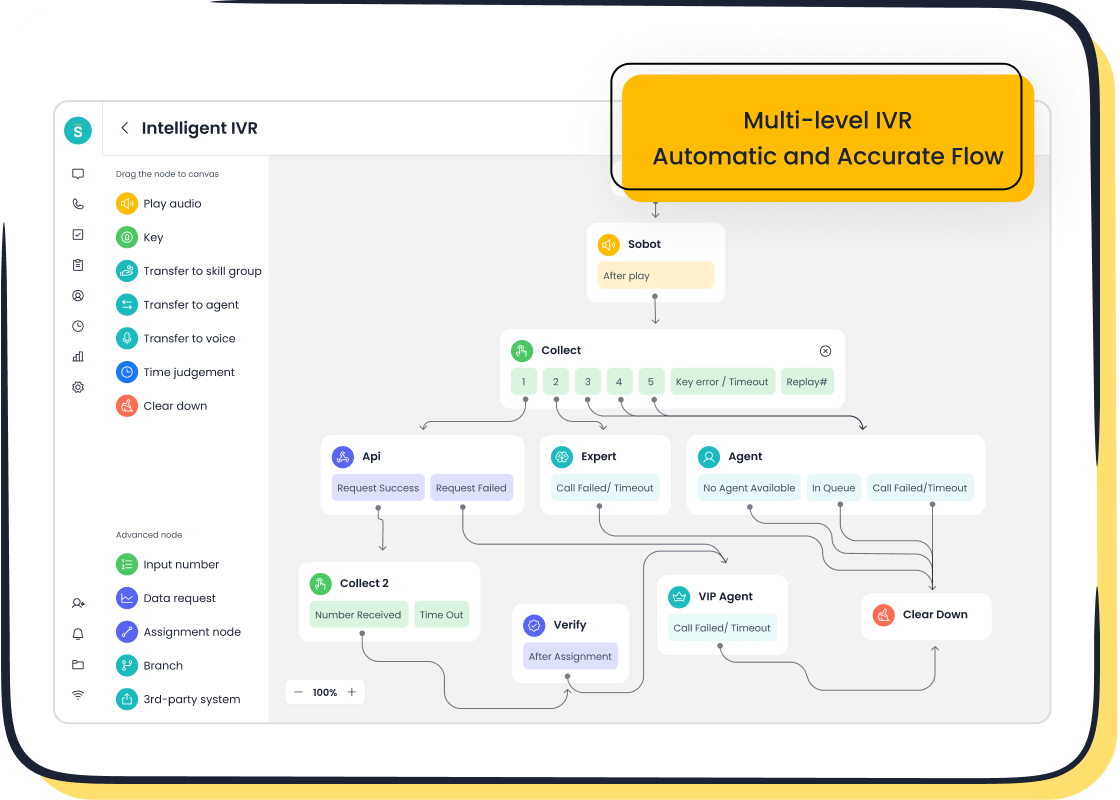
Sobot’s all-in-one contact center solutions play a vital role in improving NPS. By integrating communication channels like voice, WhatsApp, and live chat, Sobot ensures seamless interactions. Features like AI-powered voicebots and intelligent IVR enhance efficiency, reducing average handle time and improving first-contact resolution rates.
For example, Samsung leveraged Sobot’s platform to unify its communication channels and improve data connectivity. This resulted in a 30% increase in agent efficiency and a 97% customer satisfaction rate. Sobot’s ability to provide personalized service and streamline operations directly contributes to higher NPS scores, helping businesses retain customers and drive loyalty.
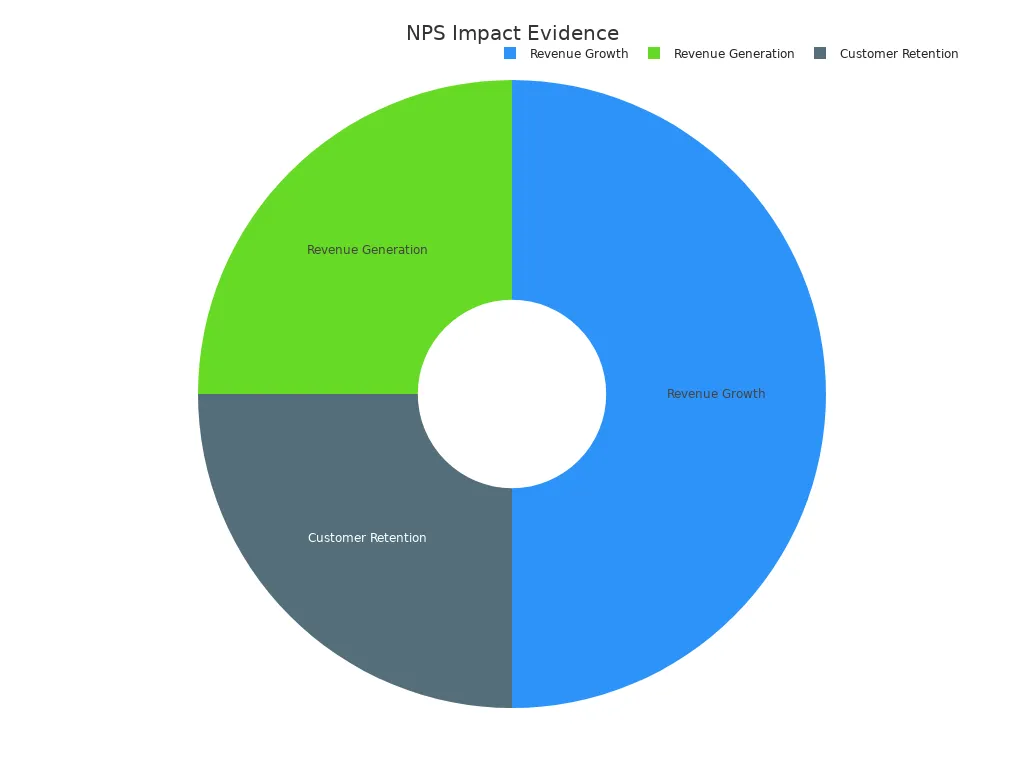
Benchmark Net Promoter Score Across Industries in 2025
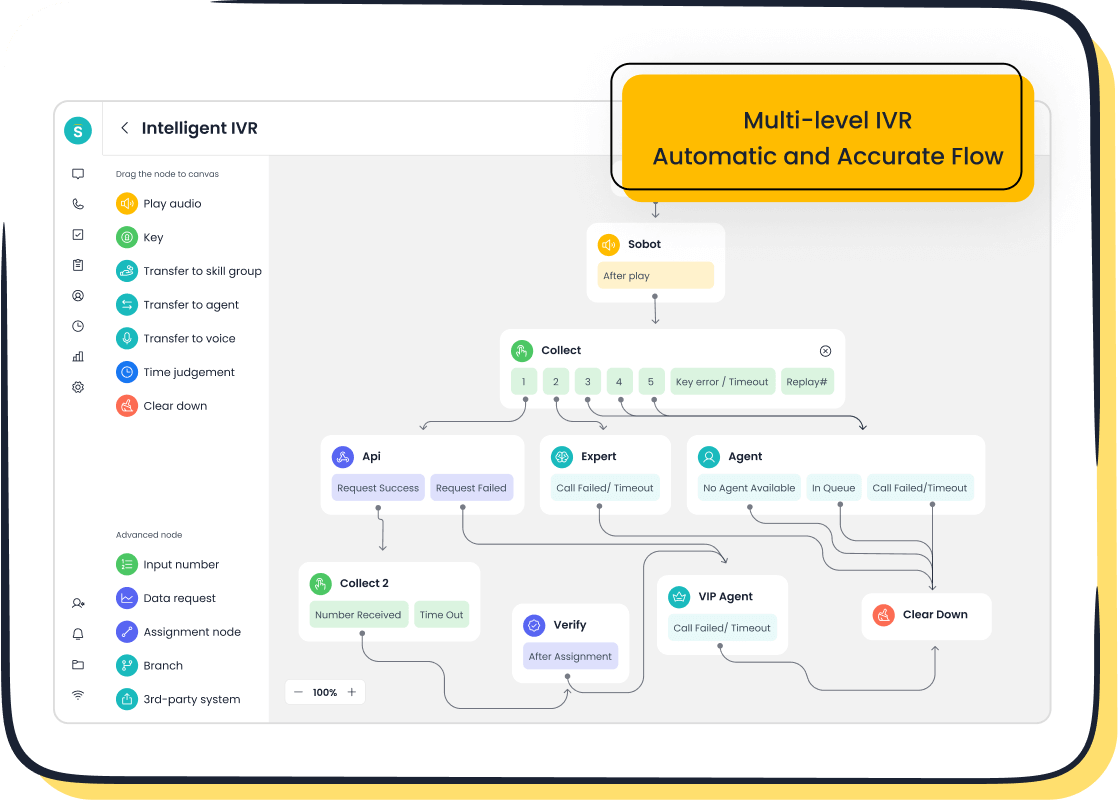
Telecom NPS Benchmarks: Trends and Insights
Telecom companies often face challenges in achieving high net promoter score benchmarks due to customer dissatisfaction with service reliability and support. In 2025, the average NPS for telecommunications remains at 31, the lowest among major industries. However, advancements like 5G technology and self-service options are improving customer experiences. Companies such as T-Mobile stand out with an NPS of 82, showcasing world-class customer satisfaction.
You can leverage telecom NPS benchmarks to identify areas for improvement. For instance, focusing on faster issue resolution and proactive communication can help you close the gap between industry averages and top performers. Customers value seamless connectivity and transparent billing, making these critical areas to address.
| Industry | NPS Average | Comparison to Telecom NPS |
|---|---|---|
| Telecommunications | 31 | Lowest industry average |
| Logistics | 38 | Higher than telecom |
| T-Mobile | 82 | World-class score |
| Customers | +50 | Above average for telecom |
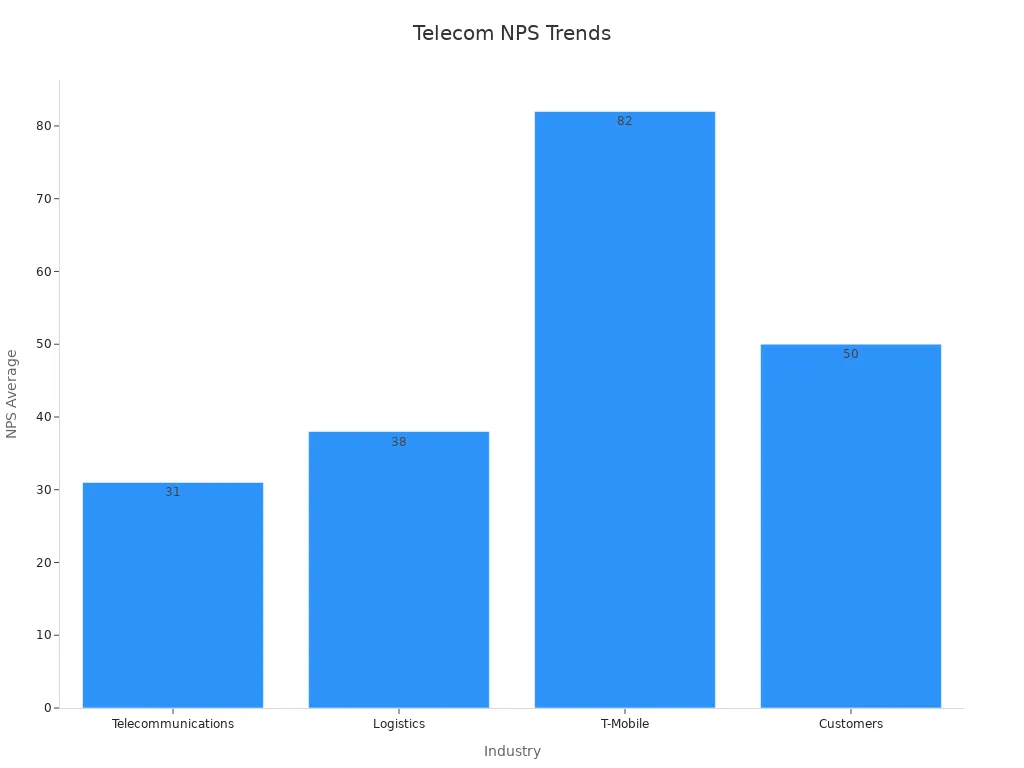
NPS Benchmarks for Retail and E-commerce
Retail and e-commerce industries continue to prioritize customer satisfaction through personalized experiences and fast deliveries. In 2025, benchmark net promoter score ranges for these sectors fall between 35 and 50. Grocery stores and retail brands achieve average NPS scores of 33.3 and 32.9, respectively, while streaming media follows closely at 32.2. Companies like Amazon demonstrate how excelling in customer experience correlates with high customer lifetime value and market dominance.
You can use NPS benchmarks to refine strategies for customer engagement. For example, offering sustainable packaging and proactive issue resolution can boost satisfaction. E-commerce companies with CSAT scores between 75% and 85% are considered healthy, while scores above 85% indicate exceptional satisfaction. By focusing on these metrics, you can enhance customer loyalty and drive repeat purchases.
| Industry | NPS Score |
|---|---|
| Grocery | 33.3 |
| Retail | 32.9 |
| Streaming media | 32.2 |
| Investment Firm | 27.9 |
| Parcel delivery | 27.7 |
| Fast food | 26.6 |
| Social media | 25.3 |
| Wireless | 24.7 |
| Auto | 24.3 |
| Bank | 23.6 |
| Food delivery | 22.9 |
| Insurance | 21.9 |
| Software | 19.5 |
| Computer and tablet makers | 17.8 |
| Hotel | 17.2 |
| Health insurance | 16.1 |
| Utilities | 15.9 |
| Electronics | 14.4 |
| TV/ISP | 12.3 |
| Airlines | 11.9 |
| Car rental | 4.8 |
| Consumer Payments | -0.1 |
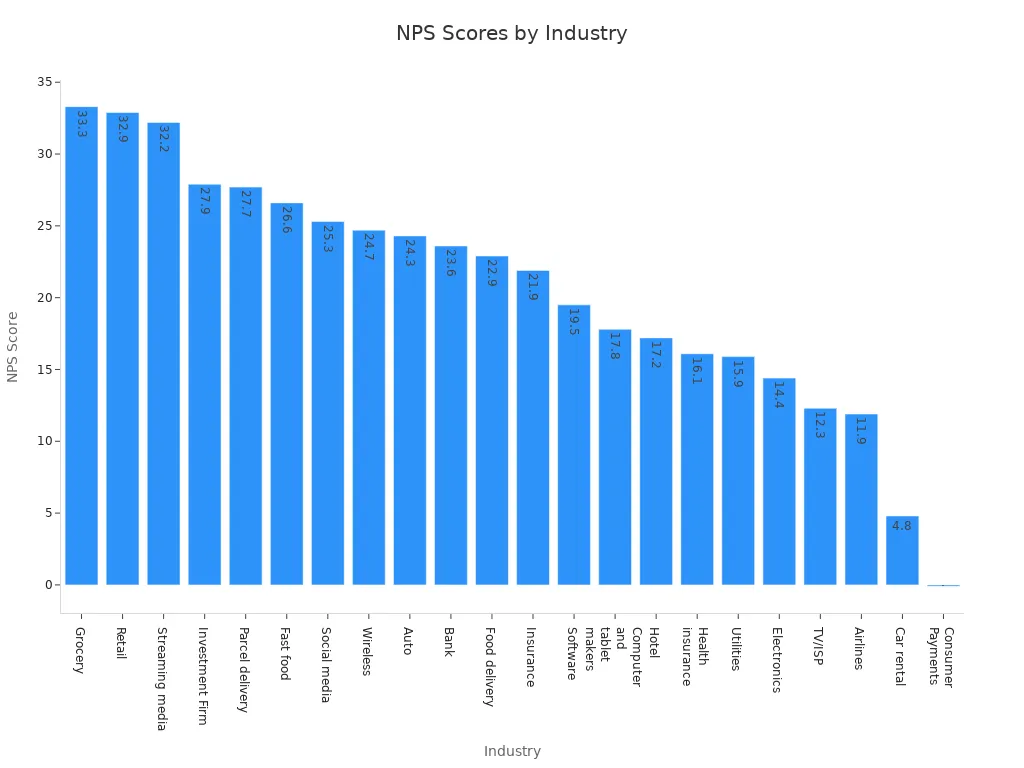
NPS Benchmarks for Financial Services and Healthcare
Financial services and healthcare sectors show contrasting trends in NPS benchmarks. Traditional banks struggle to keep pace with fintech innovations, resulting in an average NPS of 30, down from 37. Mobile-first experiences and personalized financial advice are essential for improving customer satisfaction. In healthcare, NPS scores range from 30 to 45, reflecting the growing adoption of virtual care and telemedicine.
You can use these benchmarks to identify gaps in service delivery. For financial services, enhancing mobile app functionality and offering tailored solutions can drive higher scores. In healthcare, trustworthiness and reliability remain key factors. Addressing gaps in patient engagement and care quality can significantly improve NPS. High scores in these sectors indicate strong customer trust and loyalty.
📊 Tip: Focus on mobile-first strategies in financial services and virtual care adoption in healthcare to align with customer expectations.
Industry-Specific Applications of NPS Data
Net Promoter Score (NPS) data offers valuable insights that you can apply across various industries to improve customer experiences. By analyzing NPS trends, you can identify specific areas for improvement and tailor strategies to meet customer expectations. Each industry has unique factors that influence NPS, making it essential to understand how to leverage this data effectively.
Healthcare: Enhancing Patient Satisfaction
In healthcare, NPS data helps you evaluate patient satisfaction across different services and interventions. For example, patients who undergo total hip replacement report an average NPS of 71, while those who have total knee replacement score 49. This variation highlights the importance of understanding patient experiences for specific treatments. Factors like age, gender, and the mode of service delivery also influence NPS. Older patients, for instance, often show lower willingness to recommend services.
You can use this data to improve patient engagement and care quality. Focus on streamlining processes, reducing wait times, and offering personalized care to boost satisfaction. By addressing these areas, healthcare providers can build trust and loyalty among patients.
Retail: Driving Customer Loyalty Through Quality and Service
In retail, NPS data reveals how product quality, pricing, and customer service impact loyalty. Scores in this sector typically range from 30 to 50. High-performing companies use NPS insights to refine their product offerings and enhance the shopping experience. For instance, you can analyze feedback to identify popular products or pinpoint issues with customer support.
Offering personalized recommendations, ensuring fast delivery, and maintaining competitive pricing are effective ways to improve NPS. By focusing on these areas, you can foster stronger relationships with your customers and encourage repeat purchases.
Technology: Innovating for Better User Experiences
The technology sector sees NPS scores ranging from 40 to 60, driven by innovation and user experience. Customers value intuitive interfaces, reliable performance, and responsive support. NPS data helps you identify pain points in your products or services, enabling you to make targeted improvements.
For example, if users frequently mention difficulties with software navigation, you can prioritize updates to simplify the interface. By addressing these concerns, you can enhance user satisfaction and build a loyal customer base.
Hospitality: Elevating Guest Experiences
Hospitality businesses often achieve some of the highest NPS scores, ranging from 50 to 70. Guest experience and service quality play a significant role in these scores. NPS data allows you to understand what guests value most, whether it’s personalized service, cleanliness, or amenities.
You can use this information to create memorable experiences for your guests. For instance, offering tailored recommendations for activities or providing seamless check-in processes can leave a lasting impression. These efforts not only improve NPS but also encourage positive word-of-mouth referrals.
Comparing NPS Across Industries
The following table summarizes average NPS ranges and key factors influencing scores across different sectors:
| Industry | Average NPS Range | Key Factors Influencing NPS |
|---|---|---|
| Technology | 40-60 | Innovation and user experience |
| Retail | 30-50 | Product quality, price, and service |
| Healthcare | 20-40 | Quality of service and turnaround time |
| Finance/Insurance | 20-40 | Trust and service quality |
| Telecommunications | 10-30 | Quality of service and pricing |
| Hospitality | 50-70 | Service and guest experience |
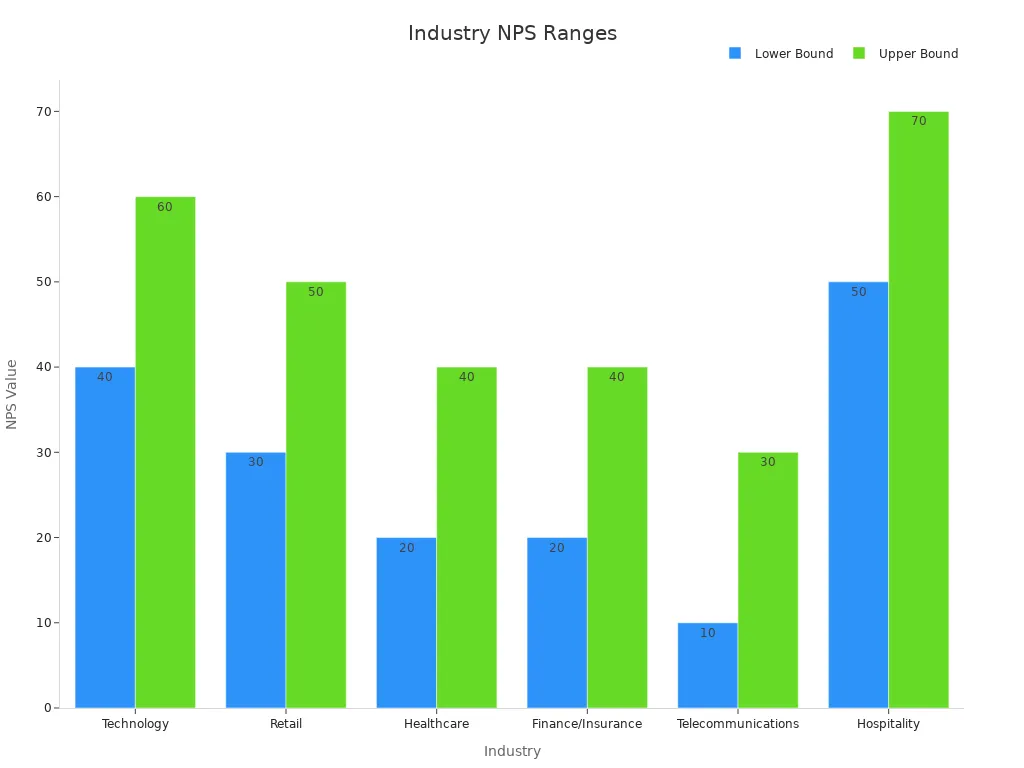
Key Takeaways for Your Business
Understanding industry-specific NPS applications allows you to focus on what matters most to your customers. Whether you’re in healthcare, retail, or technology, analyzing NPS data helps you identify strengths and weaknesses. By addressing these areas, you can enhance customer satisfaction, build loyalty, and achieve long-term success.
💡 Pro Tip: Regularly monitor your NPS trends and compare them with industry benchmarks. This practice helps you stay competitive and adapt to changing customer expectations.
Emerging NPS Trends Driving CX Innovation
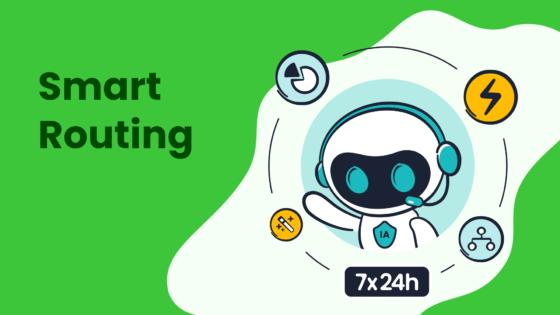
AI-Powered Insights for Personalized Customer Feedback
AI is transforming how you gather and analyze customer feedback. By leveraging machine learning and natural language processing (NLP), AI tools can perform real-time sentiment analysis to understand customer emotions. This technology enables you to deliver personalized experiences at scale, which can increase revenue by up to 15%. Additionally, 62% of respondents believe AI helps businesses understand buyers better, making it a critical tool for improving NPS.
AI-powered systems also enhance customer service by providing instant solutions. For example, Sobot’s AI-powered voicebot uses intent recognition to address customer queries efficiently. This reduces average handle time and improves first-contact resolution rates, directly boosting customer satisfaction. By integrating AI into your feedback analysis, you can identify recurring themes and act on them quickly, ensuring your customers feel heard and valued.
Omnichannel Feedback Collection and Real-Time Analysis
Omnichannel strategies allow you to connect with customers across multiple touchpoints, creating a seamless experience. Younger consumers, such as Gen Z, expect smooth transitions between digital and human interactions. Real-time feedback collection ensures you maintain high service standards across all channels. For instance, Uber uses automated in-app surveys to gather NPS data, enabling immediate issue resolution.
Traditional NPS surveys often relied on static questions and manual analysis, which limited their effectiveness. AI-based tools now offer adaptive surveys and real-time feedback analysis, helping you respond dynamically to customer needs. Multi-channel surveys, like those provided by Zonka Feedback, capture insights from various platforms, giving you a holistic view of customer experiences. This approach ensures comprehensive feedback collection and helps you identify areas for improvement.
The Growing Role of Sobot’s Voice/Call Center in NPS Optimization
Sobot’s Voice/Call Center plays a pivotal role in optimizing NPS by enhancing customer interactions. Its intelligent IVR system routes calls efficiently, while AI-powered voicebots handle repetitive queries, freeing agents to focus on complex issues. Features like real-time monitoring and feedback analysis provide actionable insights, allowing you to address customer concerns promptly.
Samsung’s implementation of Sobot’s contact center solution demonstrates its effectiveness. By unifying communication channels and improving data connectivity, Samsung achieved a 97% customer satisfaction rate and a 30% increase in agent efficiency. Sobot’s platform supports global telephony contacts and offers encrypted data transfer, ensuring secure and reliable operations. These capabilities make it easier for you to deliver exceptional customer experiences and achieve higher NPS scores.
💡 Tip: Use Sobot’s AI-powered tools to streamline feedback collection and analysis. This will help you identify trends and improve customer satisfaction.
How Customer Expectations Are Shaping NPS Trends in 2025
Customer expectations are evolving rapidly, reshaping how businesses approach Net Promoter Score (NPS) and customer experience strategies. You need to understand these changes to stay ahead in 2025.
Modern customers demand seamless experiences across multiple channels. They expect personalized interactions, quick resolutions, and consistent service quality. A Forrester survey reveals that 73% of companies now prioritize improving customer experience across channels. This shift highlights the growing importance of holistic feedback systems that capture insights from every touchpoint.
Traditional NPS methods often fall short in meeting these expectations. Gartner predicts that over 75% of organizations will abandon NPS as a measure of success for customer service and support by 2025. This trend reflects the limitations of NPS in addressing the complexities of modern customer journeys. You can no longer rely solely on a single metric to gauge satisfaction. Instead, you need comprehensive tools that analyze sentiment, behavior, and preferences.
To adapt, businesses are embracing advanced technologies like AI and omnichannel platforms. AI-powered tools help you analyze feedback in real time, uncovering deeper insights into customer needs. Omnichannel systems ensure you collect feedback from every interaction, whether it’s through voice calls, live chat, or social media. These innovations allow you to respond proactively to customer concerns, improving satisfaction and loyalty.
💡 Tip: Focus on integrating feedback mechanisms that align with customer expectations. Use tools like Sobot’s Voice/Call Center to streamline interactions and gather actionable insights.
By understanding these trends, you can refine your strategies to meet evolving demands. Customers value businesses that listen and adapt. When you prioritize their expectations, you build trust and foster long-term loyalty.
Actionable Strategies to Improve NPS Scores
Leveraging Technology to Enhance Customer Feedback Systems
Technology plays a crucial role in improving NPS by streamlining feedback collection and analysis. AI-driven tools help you gather insights faster and more accurately. For instance, Koçtaş increased its NPS by 60% within nine months by implementing AI-powered feedback loops. This approach reduced complaint volumes and empowered employees to address customer needs proactively. Similarly, Sharekhan achieved a 30-point NPS increase after deploying AI-driven CX tools, which also led to reduced churn and higher cross-selling opportunities.
You can use technology to automate surveys and analyze sentiment in real time. Pairing NPS with other metrics like CSAT and CES provides a comprehensive view of customer satisfaction. Tools like Sobot’s Voice/Call Center integrate AI-powered voicebots and intelligent IVR systems to enhance customer interactions. These features reduce average handle time and improve first-contact resolution rates, directly boosting customer satisfaction and retention.
📊 Tip: Regularly track NPS progress using AI-powered dashboards to foster accountability and transparency across teams.
Engaging Employees to Drive Customer Satisfaction
Employee engagement significantly impacts NPS and overall customer satisfaction. Gallup’s research shows that engaged employees contribute to a 20% increase in sales and a 10% rise in customer ratings. Companies with high employee engagement scores experience a 20% boost in customer satisfaction, highlighting the importance of empowering your team.
You can improve employee engagement by providing training, recognizing achievements, and fostering a collaborative environment. When employees feel valued, they deliver better service, which enhances customer experiences. For example, Sobot’s unified workspace simplifies workflows, enabling agents to focus on resolving customer issues effectively. This approach not only improves efficiency but also strengthens employee morale.
| Statistic | Impact |
|---|---|
| 20% increase in customer satisfaction | High employee engagement scores |
| 10% increase in customer ratings | Engaged employees |
💡 Pro Tip: Share NPS feedback with your team regularly to help them understand customer pain points and align their efforts with organizational goals.
Using Sobot’s AI-Powered Voicebot for Efficient Customer Interaction
Sobot’s AI-powered Voicebot revolutionizes customer interactions by providing intelligent and efficient solutions. It uses intent recognition to address queries instantly, reducing average handle time and improving first-contact resolution rates. Samsung’s implementation of Sobot’s platform showcases its effectiveness. The company achieved a 97% customer satisfaction rate and a 30% increase in agent efficiency by leveraging Sobot’s AI-powered tools.
The Voicebot also enables seamless integration with CRM systems, ensuring agents have access to comprehensive customer data. This feature allows you to personalize interactions and resolve issues faster, enhancing customer satisfaction and retention. With global telephony support and encrypted data transfer, Sobot’s Voicebot ensures secure and reliable operations, making it an essential tool for improving NPS.
🚀 Note: Use Sobot’s AI-powered Voicebot to automate repetitive tasks and focus on delivering personalized experiences that drive loyalty.
Building a Culture of Continuous Improvement in CX
Creating a culture of continuous improvement in customer experience (CX) ensures your business stays competitive. It involves fostering an environment where teams constantly seek ways to enhance processes, interactions, and outcomes. This approach not only improves customer satisfaction but also strengthens loyalty and trust.
To build this culture, you need to align your teams with a shared vision. When everyone works toward the same goal, silos break down, and collaboration improves. For example, a retail company enhanced the customer journey by integrating real-time inventory updates. This change made transitions from online shopping to in-store pick-up seamless, resulting in a better experience for customers.
Steps to Foster Continuous Improvement in CX
-
Encourage Feedback at Every Level
Collect feedback from customers and employees regularly. Customer insights help you identify pain points, while employee suggestions often reveal operational inefficiencies. Use tools like Sobot’s Voice/Call Center to gather real-time feedback across multiple channels. This ensures you address issues promptly and effectively. -
Invest in Training and Development
Equip your team with the skills they need to deliver exceptional service. A telecommunications company improved its call center services by training agents and implementing AI chatbots. This shift enhanced service quality and revealed valuable insights into customer happiness. -
Leverage Technology for Continuous Monitoring
Use advanced analytics to track performance metrics like the customer satisfaction index. AI-powered tools can analyze trends and identify areas for improvement. For instance, Sobot’s intelligent IVR system provides actionable insights, helping you refine processes and meet customer expectations. -
Celebrate Small Wins
Recognize and reward efforts that contribute to better CX. Celebrating achievements motivates your team and reinforces the importance of continuous improvement. Even small changes, like reducing wait times or simplifying processes, can significantly impact the customer retention rate.
Benefits of a Continuous Improvement Culture
- Enhanced Customer Satisfaction: A focus on improvement ensures you consistently meet or exceed customer expectations.
- Increased Loyalty: Customers are more likely to stay with brands that prioritize their needs.
- Operational Efficiency: Streamlined processes reduce costs and improve service delivery.
💡 Pro Tip: Regularly review your CX strategies and adapt them based on feedback and performance data. This practice keeps your business aligned with customer needs and market trends.
By fostering a culture of continuous improvement, you create a foundation for long-term success. Customers notice when you prioritize their experience, and this effort translates into higher satisfaction and loyalty.
The Future of NPS and CX Strategies Beyond 2025
Predictions for NPS Evolution and Industry Benchmarks
The evolution of NPS will reshape how you approach customer experience strategies. Brands will focus on hyper-personalization, tailoring interactions to meet individual needs. AI integration will play a key role, enabling real-time sentiment analysis and predictive insights. Companies will shift their focus from addressing individual feedback to implementing systemic changes that improve overall experiences.
In healthcare, personalized preventative care will gain traction. Providers will use AI-powered tools to create customized care plans, meeting patient expectations more effectively. Across industries, transparency and accountability will become essential for building trust with customers. Real-time employee empowerment will also emerge as a priority, allowing teams to address customer concerns promptly.
💡 Tip: Embrace AI-driven tools like Sobot’s Voice/Call Center to streamline processes and deliver tailored experiences that boost customer satisfaction.
Staying Ahead with Sobot’s Omnichannel Contact Center Solutions
Sobot’s omnichannel contact center solutions help you stay ahead in the evolving CX landscape. By integrating communication channels like voice, WhatsApp, and live chat, Sobot ensures seamless interactions. Its AI-powered voicebot enhances efficiency by addressing repetitive queries, freeing agents to focus on complex issues.
Samsung’s success story highlights the impact of Sobot’s solutions. By unifying communication channels and improving data connectivity, Samsung achieved a 97% customer satisfaction rate and a 30% increase in agent efficiency. Sobot’s platform also supports global telephony contacts and encrypted data transfer, ensuring secure operations. These features make it easier for you to deliver exceptional experiences and achieve higher NPS scores.
| Key Findings | Implications |
|---|---|
| NPS predicts future sales growth under certain conditions. | Supports the continued use of NPS in managerial practice. |
| Changes in NPS, rather than absolute scores, are significant predictors of sales growth. | Firms should focus on improving and communicating changes in NPS. |
| NPS serves as a forward-looking metric for brand health. | Brands should track NPS for all potential customers to drive growth. |
Leadership’s Role in Driving NPS Success
Leadership plays a critical role in driving NPS success. You can create processes that reinforce skill development, such as journal clubs or training sessions. Developing templates and tools for evidence-based decision-making ensures your team aligns with organizational goals.
Stakeholder surveys help you identify strengths and areas for improvement. Incorporating evidence-based interventions into your strategic plan enhances both employee and customer experiences. Leaders who prioritize transparency and accountability foster trust, which directly impacts NPS.
🚀 Note: Share NPS feedback with your team regularly to align efforts and improve customer satisfaction.
Understanding NPS benchmarks gives you a multifaceted view of customer relationships. Combining NPS with other metrics, such as CSAT, provides actionable insights for improving customer satisfaction. For example, a +50 NPS in retail signals strong performance, while utilities may consider +30 impressive. Sobot’s solutions, like its AI-powered Voicebot, simplify feedback collection and analysis, helping you identify friction points and enhance experiences. By prioritizing NPS, you can benchmark against competitors, refine strategies, and foster loyalty among customers. This focus ensures your business stays competitive and aligned with evolving expectations.
FAQ
What is a good Net Promoter Score (NPS) for my industry?
A good NPS varies by industry. For example, hospitality often scores between 50-70, while telecommunications averages around 31. Compare your score to industry benchmarks to evaluate your performance. Aim for a score above 50 to indicate strong customer loyalty.
How can Sobot’s solutions help improve my NPS?
Sobot’s solutions enhance customer interactions through AI-powered tools like voicebots and intelligent IVR. These features reduce response times, improve first-contact resolution rates, and provide personalized service. By streamlining communication, you can boost customer satisfaction and loyalty, leading to higher NPS scores.
Why is NPS important for customer experience strategies?
NPS measures customer loyalty and satisfaction. It helps you identify promoters, passives, and detractors. By analyzing this data, you can pinpoint areas for improvement, enhance customer experiences, and drive retention. High NPS scores often correlate with increased revenue and organic growth.
How does AI impact NPS feedback collection?
AI simplifies feedback collection by automating surveys and analyzing sentiment in real time. Tools like Sobot’s AI-powered voicebot identify recurring themes and customer needs quickly. This allows you to act on feedback faster, improving satisfaction and boosting your NPS.
Can NPS predict business growth?
Yes, NPS serves as a forward-looking metric for brand health. Changes in NPS often predict sales growth. By improving your NPS, you can enhance customer loyalty, increase repeat purchases, and drive long-term business success.
See Also
Best Call Center Analytics Tools To Consider In 2024
Leading Contact Center Solutions Evaluated For 2024
Best Voice Of The Customer Tools For 2024
